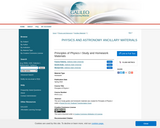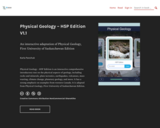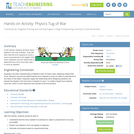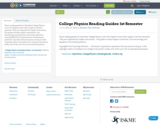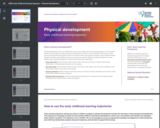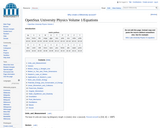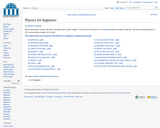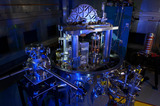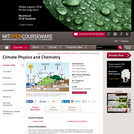Short Description:
This supplementary first-year physics textbook explores the role of language, alongside figures and mathematical symbols, in solving physics problems. The aim of this textbook is to help students gain extended, practical awareness of the roles of language in solutions to a range of first-year physics problems. The learning is guided mainly by comparing how language is used in formal, written solutions and in students' problem-solving dialogues. With new awareness how and why language is used in these two central forms of university physics practice, students can more effectively communicate solutions and guide their development as physicists and users of scientific English. After introducing problem-solving strategies and foundational aspects of language, the textbook guides students in the three primary functions of language in solutions: to represent concepts and phenomena, organize messages to facilitate their interpretation, and evaluate knowledge claims. Learning is largely task-based, emerging from completing the textbook tasks and reviewing feedback. The textbook is recommended for use alongside first-year physics instruction in self-guided study or instructor-facilitated contexts such as physics tutorials and English for physics courses.
Long Description:
This textbook combines the perspectives of physics and language to help you solve first-year physics problems and communicate your problem-solving choices more consciously and effectively. From the view of physics, the units present physics problems linked to the set of physics concepts typically taught in first year, focusing on how students with various physics competencies solve problems in dialogue and report their solutions in writing. By exploring the various competencies involved in solving physics problems and illustrating these competencies in solutions produced by students with different strengths and weaknesses, this textbook aims to help you understand and develop your own competencies.
A language perspective on learning first-year physics
The perspective of language complements the learning in physics because language systems are a key resource for thinking through and solving physics word problems. Language use in specialized activities such as solving physics problems tends to form identifiable patterns, implying that some language choices are more effective than others. Working through this textbook, you will observe the systems of language choices available for solving physics problems and develop capacities to use language more mindfully and effectively in your physics work.
Physics knowledge is produced, exchanged, and assessed in two main forms in first year courses, in speech and writing. In each textbook unit, a problem is introduced that requires application of one or more focal physics concepts, exploring spoken and written solutions to this problem to help you improve the effectiveness of solutions in both forms. Each unit also focuses on a specific function or sub-function of language, such as how concepts are represented or how solutions are organized, which is explored by comparing the spoken and written modes of communicating physics.
Across the 14 units, the textbook describes and explains the functional scope of the English language in shaping valued physics knowledge. For example, we explore the use of particular functional structures of English that physicists typically use when a problem requires us to re-interpret the concrete, physical world in terms of abstract concepts, such as when modelling a running person (concrete) as a point mass (concept).
The language perspective helps us answer questions such as these: What are the functions of language in solving physics problems? How does language help us to shift perspectives between a problem’s dynamic, physical situation and the stable, theoretical concepts involved? What are the roles of visual figures and mathematical symbolism relative to language in solving physics problems? What language choices are involved in effectively solving a physics problem in group dialogue and writing? Can we distinguish between reporting and explaining our solution? If so, how? What does it mean for a solution to be effectively communicated?
The knowledge and experiences you build in this course about the role of language in physics will help you to meet your expectations for solving physics problems and those of your peers and instructors. This aim is achieved in combination with the increased awareness and development of your competencies in solving physics problems. The guiding aim of this textbook is for you to apply the knowledge and experiences you gain towards your personal and professional development according to your interests in physics and science.
The organization of the textbook
The roles of language in solving physics problems are explored in increasing detail across the textbook units. Unit 1 provides the foundational perspectives on physics and language. The focus for learning is on strategies for solving word problems and the units and scales of language use in communicating the solutions.
Units 2 to 14 focus on physics concepts typically covered in first year, from motion along a straight line to fluid dynamics. Each unit introduces a problem developed to apply the unit’s focal concept and explores with you the solutions to these in spoken and written forms. A second problem is then introduced in the unit as an opportunity to apply, assess, and reflect on what you’ve learned.
Ways to use the textbook
The focus of this textbook is on improving your use of language, problem-solving strategies, and physics concepts in solving problems. As such, this book is not intended to replace a physics first-year textbook. Rather, this textbook is designed to be used in combination with a standard first-year physics textbook or course, where the methods and concepts are covered in detail.
This textbook is designed for first-year Science or Applied Science programs, where it would be used in (1) the tutorial section of the physics course focusing on problem-solving competencies and communicating solutions or in (2) a linked content-and-language syllabus such as an English for First-Year Physics course. This textbook will also find good use in (3) advanced placement high-school science programs, (4) pre-sessional university preparation programs, and (5) refresher courses for first-year physics. The book was designed especially for multilingual students of physics; however, it is expected to interest any physics enthusiasts with an interest in explicit understanding and extended practice of the language of physics.
The course is designed to be used in self-guided learning, peer study groups, or instructor-led classes. Whatever approach you take, learning through this textbook happens through your active engagement with the tasks. The task-based design involves a cycle of pre-task preparation, task activity, and post-task checking of responses and reflection. The post-task checking of your responses is crucial as this is typically where the effectiveness of your task performance is explained, that is, where the teaching emerges in dialogue with your input.
This course also includes optional features for deeper engagement and community-building around the language of solving physics problems. Chief among these features is the sharing of physics problems and solutions produced by you, the textbook users. As a user of the online textbook, you are invited to submit your solutions to the collection and compare these in terms of language features against our analyses of how language is used across all submissions. Users are also encouraged to design and share unique problems that reflect their particular interests and curiosities within and beyond physics. As the collection grows, so will the analyses, opportunities for engagement, and the learning community.
Word Count: 6443
(Note: This resource's metadata has been created automatically by reformatting and/or combining the information that the author initially provided as part of a bulk import process.)
